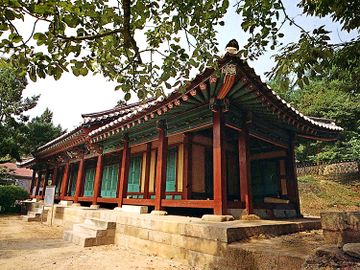온온사
| 온온사 Ononsa Guesthouse |
|
 온온사, 국가문화유산포털, 문화재청. |
|
| 대표명칭 | 온온사 |
|---|---|
| 영문명칭 | Ononsa Guesthouse |
| 한자 | 穩穩舍 |
| 주소 | 경기도 과천시 관악산길 58 (관문동) |
| 지정(등록) 종목 | 시도유형문화재 제100호 |
| 지정(등록)일 | 1980년 6월 2일 |
| 분류 | 유적건조물/정치국방/궁궐·관아/관아 |
| 시대 | 조선시대 |
| 수량/면적 | 187㎡ |
| 웹사이트 | 온온사, 국가문화유산포털, 문화재청. |
|
|
|
목차
해설문
국문
조선시대 인조 27년(1649년)에 지어진 과천현의 객사이다. 객사는 임금을 상징하는 나무패인 전패를 모셔놓은 곳으로, 일정한 날짜에 임금이 계신 궁궐을 향해 절을 하는 의식을 치렀다. 이외에도 외국에서 온 사신이나, 나라의 일을 하는 관리들의 숙소로 이용되었다. 객사는 고을의 수령이 일을 하는 동헌보다 더 지위가 높다. 그래서 고을의 가장 중심이 되는 곳에 위치하며 건물도 정성을 다해 지었다.
온온사는 정조임금께서 수원에 있는 아버지 사도세자의 묘소인 현륭원(顯隆園)에 참배하고 돌아오던 길에 머물며 붙여주신 이름으로 ‘경치가 아름답고 몸이 편안하다는 뜻’을 담고 있다.
정청(政廳) 3칸이 중앙에, 좌우로 동·서현이 각각 3칸으로 구성되어 있는데, 정청 부분 지붕을 동·서현보다 약간 높게 지은 전형적인 객사 건물의 형태를 갖추고 있다. 원래는 현재의 중앙동사무소자리에 있었는데 1986년에 이곳으로 옮겨 세웠다.
유의사항
우리의 문화재, 함께 아끼고 지켜요.
- 허가되지 않은 곳은 함부로 들어가지 않습니다.
- 애완동물들은 출입할 수 없습니다.
- 음식을 만들거나 술을 먹을 수 없습니다.
- 다른 사람들이 편안하게 즐길 수 있도록 시끄럽게 떠들지 않습니다.
- 문화재는 불에 약합니다. 불이 잘 붙는 물질이나 쓰레기는 잘 치워주세요.
- 이외에도 문화재 보호에 문제가 될 것 같은 행동은 참아주세요.
문화재는 민족의 얼이 담긴 우리의 재산이며, 민족의 주체성을 일깨워 주는 우리의 자부심입니다. 선대의 문화유산을 잘 가꾸어 후손에게 물려주는 지혜로운 문화인이 됩시다.
과천현 관아지
과천현의 수령이 업무를 보던 건물인 관아가 있었을 것으로 추정되는 곳이다.
과천현의 관아는 조선 초기 무학대사의 제자인 열이 세웠을 것으로 추정되나 기록이 없어 정확한 내용은 알 수가 없다. 다만 임금이 묘소(능), 온천, 사냥을 오고 가면서 이용하던 행궁의 기능과 지방 관청의 기능을 모두 처리했기 때문에 다른 곳의 관아보다 규모가 더 컸을 것으로 추정된다.
발견되는 석조유물(돌로 만들어진 물건)과 노거수목(나이가 많은 나무)으로 보아 현재까지 남아 있는 온온사를 중심으로 관아가 지어졌을 것으로 보고 있다.
과천현 신수읍지(숙종25, 1699년 작성)에 과천현 관아에 관한 기록이 다음과 같이 남아 있다.
영문
Ononsa Guesthouse
Guesthouses (called gaeksa in Korean) were built nearby local government offices during the Joseon period (1392-1910). Guesthouses include a shrine in the center to hold a wooden tablet symbolizing the king and two rooms to either side which were used as temporary lodging facilities for officials visiting from other regions. The wooden tablet enshrined in each local guesthouse exhibited the king’s sovereignty across the country. To acknowledge this sovereignty, the local magistrate and other officials regularly performed a ceremony in which they bowed deeply toward the royal capital.
Ononsa was built in 1649 as a guesthouse of the Gwacheon Local Government. It was originally located on the site of today’s Jungang-dong Community Service Center. In 1986, the building was dismantled and rebuilt at the current location.
Its name, meaning “a comfortable residence with a beautiful landscape,” was bestowed by King Jeongjo (r. 1776-1800) in 1790 when he stayed here on his way back to the capital after visiting his father’s tomb in today’s Hwaseong area.
Notice
Please help us take care of our precious cultural heritages by following these rules:
- Do not enter unauthorized places without permission.
- Do not bring pets into the premises.
- Do not make food or drink alcohol.
- Do not speak loudly as to disturb other visitors.
- Please properly dispose of any flammable items or trash.
- Please refrain from any other activities which threaten the preservation of the cultural heritages.
As reminders of our identity and history, cultural heritages are our shared property and pride. Let's take care of our heritage and pass it on to future generations by being wise patrons.
Gwacheon Local Government Site
This site is presumed to have been occupied by the local government of the Gwacheon area during the Joseon period (1392-1910). The local government was established in the early 15th century, but it is unknown when its office building was first built.
The local government office and its auxiliary buildings were also used as a temporary residence of the king and royal entourage. The kings of Joseon often stayed here along their journeys to and from the Chungcheong-do area or the southern area of Gyeonggi-do for visiting ancestors’ tombs or hot springs. It is presumed that the size of the government complex was larger than other local government to properly serve as the king’s residence.
영문 해설 내용
객사는 조선시대에 고을 관아에 설치했다. 객사는 가운데에 왕의 전패를 모신 정당이 있고 좌우 양쪽에는 다른 지방에서 파견된 관리가 숙소로 사용되던 익실이 있다. 객사에 모셔진 전패는 왕의 통치권을 상징하는 것이다. 이러한 통치권을 바탕으로 고을 수령과 관리들은 궁궐을 향해 절하는 망궐례를 행했다.
온온사는 1649년 과천현의 객사로 지어졌다. 원래는 현재의 중앙동사무소 자리에 있었는데, 1986년에 해체하여 현재의 위치에 다시 지었다.
온온사라는 이름은 ‘경치가 아름답고 몸이 편안하다’는 뜻으로, 정조가 1790년 수원에 있는 아버지 묘소에 참배하고 돌아오던 길에 머물며 하사한 이름이다.
과천현관아지
이곳은 과천현의 관아가 있던 것으로 추정되는 곳이다. 과천현은 15세기 초에 설치되었으나, 관아가 정확히 언제 처음 지어졌는지는 알 수 없다.
과천 관아는 왕의 임시 거처로 사용되기도 하였다. 왕은 선조의 묘에 참배하거나 온행을 위해 경기도 남부 지역이나 충청도에 행차할 때 이곳에 머물렀다. 행궁으로 사용되기 위해 다른 곳의 관아보다 규모가 더 컸을 것으로 추정된다.